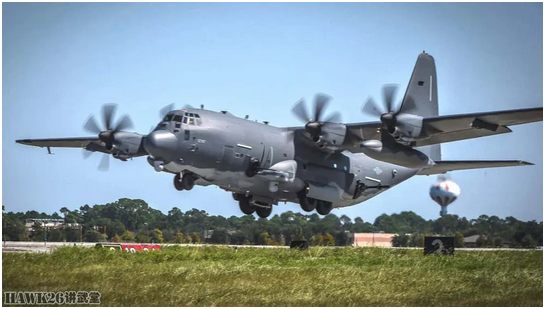US military AC-130 gunboat aircraft trials new 105mm howitzer
Recently, the US Navy announced that its engineering team has developed an improved 105mm howitzer, which will be equipped with the US Air Force's AC-130 gunboat aircraft. At present, the US Air Force AC-130W Stinger II and AC-130J Ghostrider gunboats are still equipped with howitzers used by the US Army in the 1960s, which are no longer in service with other US military units. According to an official press release from the US military, the design team led by engineers at the Naval Surface Warfare Center Dahlgren Branch (NSWCDD) in Virginia has successfully developed a new product to replace the improved M102 howitzer on the US Air Force AC-130W and AC-130J.The US Navy Sea Systems Command (NAVSEA) announced earlier this month that the team has successfully manufactured and delivered at least one prototype howitzer.

The improved howitzer developed by the US Navy is called Gun Aviation Equipment (GAU), which is a standard prefix in the US Air Force Navy Joint Naming System. Guns installed on aircraft typically use this numbering prefix. For example, the "Bushmaster II" 30mm machine gun equipped on the AC-130W and AC-130J gunboats is named GAU-23/A using this naming system. At present,it is unclear whether the howitzer developed by NSWCDD is a completely new design or includes components of the M102. The US Navy describes it as an upgraded version, which does have some features similar to the M102, such as the installation of a muzzle brake on the top of the gun body, which is the same as the old M102 Army howitzer.According to NAVSEA,"The M102 howitzer and M137A1 recoil mechanism used in the 105mm gun system of the AC-130 are no longer provided by the US Army, which means that designing new devices to replace outdated original mechanisms and upgrading the gun system technology has become a necessary choice. The upgrade work for the 105mm GAU is fully underway, and NSWCDD engineers will carefully ensure that weapon functionality, firing accuracy, and reliability remain largely unchanged In 1970, the US Air Force first tested an improved version of the M102 howitzer, planned to use it as a new equipment for the AC-130 gunboat, which was also part of the "Pave Aegis" project. The following year,the US Air Force began installing this type of howitzer on multiple AC-130E aircraft, which were subsequently used in wars in Southeast Asia. The 105mm howitzer became the standard weapon for all subsequent AC-130H and AC-130U gunboats.
The US Air Force initially did not plan to install this 102mm howitzer on more advanced AC-130W and AC-130J gunboat aircraft, which emphasized precision guided ammunition and reduced the gun to one GAU-23/A 30mm machine gun. However, compared to precision guided bombs and missiles, the M102 howitzer provides special combat capabilities, especially its ability to quickly hit a large amount of firepower in a relatively small target area, and then quickly shift the focus of the strike to another target area. Howitzers can also fire different types of ammunition, including airburst shells, thereby improving the effectiveness and flexibility of striking different targets. Although the GAU-23/A machine gun has some similar firepower flexibility,the power of 30mm shells is far less than that of 105mm shells, which can destroy buildings, strike solid targets (such as shelters), and destroy armored vehicles. In the end, the US Air Force changed its initial plan and added the M102 105mm howitzer to the AC-130W "Stinger II" and AC-130J "Ghost Knight" gunboat aircraft as part of their technological upgrades.

Of course, the problem is that the M102 is an outdated model that has long been discontinued and is no longer equipped in other combat units of the US military, and this type of howitzer is gradually being retired in other countries. So, maintaining a small number of 105mm howitzers on the US Air Force AC-130 gunboat has become increasingly costly and technically challenging. This is not the first time the US Air Force has encountered weapon system aging issues on the AC-130. The AC-130U gunboat aircraft, which has now been fully retired, is the last combat platform in the US military equipped with a 40mm Bofors gun. Before the retirement of AC-130U, in order to ensure the use of these Bofors guns and collect necessary spare parts and ammunition, the US Air Force even searched for gun barrels in foreign weapon inventories and refurbished ammunition inventories from World War II. As for why the US Navy chose to develop this improved 105mm artillery system for the Air Force's AC-130, the real reason is still unclear. It is speculated that the US Navy may have some design experience with ultra large caliber artillery, which can accurately fire on ships and quickly turn in other directions. Anyway, the engineers at NSWCDD have extensive experience in AC-130 related projects. Previously, a 105mm howitzer kit was developed for the AC-130W and AC-130J, and laser weapons were installed on the AC-130J gunboat. Now, NSWCDD is once again accepting the demand from the US Air Force to ensure that the current AC-130 gunboat aircraft can continue to use 105mm howitzers in the foreseeable future, in addition to being equipped with other weapon systems.
Source: Military of Strong Countries